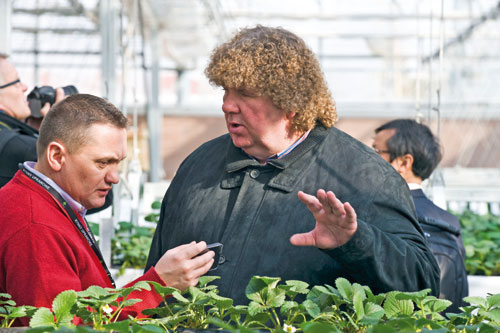Hopes that new strawberry varieties prove fruitful
Updated: 2012-02-27 09:29
By Zhou Siyu (China Daily)
|
|||||||||||
|
Two foreign business people discussing strawberry planting technology and varieties at the seventh International Strawberry Symposium that started on Feb 18 in Beijing. Antonio Ruffo, chief executive officer of Fruitgrowing Equipment and Service Srl, an Italian company, said he sees great potential for his strawberry business in China. [Photo/China Daily] |
BEIJING - Like many European businessmen, Antonio Ruffo travels frequently between Europe and China. But what he brought to the Asian country was something different - strawberries.
Ruffo is the chief executive officer of Fruitgrowing Equipment and Service Srl, an Italian company. The company does its business by granting licenses for planting fruit varieties developed by research institutes and companies and charging the growers for royalties. In a trip to China three years ago, Ruffo discovered a thrilling fact.
"Just 5 percent of China's (strawberry) market is equal to Spain's total," he said. China, the world's largest strawberry grower and consumer, has a growing area of 120,000 hectares, more than those in Italy and Spain combined, industry data showed.
In addition to the sheer scale, the country's growing economy also plays a factor.
"I have seen a surging middle-class in China, which demands cars, clothes, houses and many other high quality goods. They will need better fruit, too," Ruffo said at the 7th International Strawberry Symposium that started on Feb 18 in Beijing.
To satisfy Chinese people's increasingly delicate palates, agricultural experts said farmers need to grow new strawberry varieties in their fields.
"Chinese farmers now plant the same varieties that those in more advanced countries grew at least 15 years ago," said Ji Hongyu, an agronomist with Donggang Strawberry Research Institute, a major association in Northeast China's Liaoning province.
These varieties were cheaper because their intellectual property protection expired and the farmers did not have to pay royalties.
But at the same time, these varieties were vulnerable to diseases and had lower yields and a shorter shelf time compared with new ones, Ji said.
According to Ji, 70 percent of China's strawberry fields were planted with outdated varieties. "We need better varieties," he added.
To cater to the country's needs, Ruffo started testing European varieties two years ago with strawberry institutes across China. The varieties Ruffo intended to introduce to the country were developed by companies such as the Spanish Planasa SA Group, one of the largest fruit researchers in Europe.
"We are very optimistic about our future business in China," said Ivan Leache, commercial manager at Planasa, who came to Beijing with Ruffo. "We expect to set up an office in China within the next five years."
Other companies shared the ambition to tap into the country's promising market. Lassen Canyon Nursery Inc, a company based in the United States, came to China four years ago. With 50 years of experience in the strawberry business, the nursery grew strawberry plants for, and sold customized equipment to, Chinese farmers.
Lassen Canyon Nursery Inc currently has a "very small" market share and is looking for better varieties to introduce to China, said Randall Ito, the company's general manger in China.
The company saw business grow in China last year. "We hope to see our business continue expanding this year", he added.
In the meantime, companies still have concerns about the country's intellectual property rights' protection for their varieties.
"I have been fighting against infringements for 35 years in Europe. I understand it would take time for (Chinese) farmers to adapt," Raffo said.
As a result, Raffo decided to take things slowly. He charged European farmers 20 euros ($26) of royalties for 1,000 strawberry plants, compared with 6 euros in China. With 1,000 plants, farmers could produce a ton of strawberries.
"In China's market, what matters is the quantity," he said.
Chinese institutes and local governments welcomed the new varieties and technologies with open arms. This month, Ruffo signed an agreement with the local government in Beijing's Changping district to set up a strawberry research institute in the north of the captial city.
According to the agreement, Ruffo will provide the institute with new varieties as well as advanced cultivation technology. The local government will provide land, labor and all the other facilities, he said.
Economic gains seemed to have justified the local government's efforts to develop the strawberry industry in recent years. In Changping district alone, gross output value for the strawberry industry last year was 250 million yuan ($39 million), the most lucrative sector in the district's agricultural industry, local media reported.
Companies in related sectors also benefit from the tasty red fruit. Beijing Goldenway Bio-Tech Co Ltd, a company that converts kitchen waste into biofertilizers, has had its products sprayed on local strawberry fields totaling 667 hectares since 2005.
The company's products helped keep the land fertile, which made it possible for farmers to grow strawberries on the same plot of land for eight years, Goldenway's Chief Executive Officer Yu Jiayi said.
"Strawberries grow sweeter every year on the land fertilized by our products," she added.
Related Stories
Sandstorms fail to break rock spirit 2011-05-03 07:56
Creamy strawberry moscato torte 2011-07-24 15:54
Creamy strawberry moscato torte 2011-07-24 15:54
Strawberry flavor for London 2012 2011-02-24 07:53
Gene codes cracked for chocolate and the wild strawberry 2010-12-28 08:07
6th China (Dandong Donggang) Strawberry Cultural Festival inaugurated 2011-06-01 15:56
Today's Top News
President Xi confident in recovery from quake
H7N9 update: 104 cases, 21 deaths
Telecom workers restore links
Coal mine blast kills 18 in Jilin
Intl scholarship puts China on the map
More bird flu patients discharged
Gold loses sheen, but still a safe bet
US 'turns blind eye to human rights'
Hot Topics
Lunar probe , China growth forecasts, Emission rules get tougher, China seen through 'colored lens', International board,
Editor's Picks

|

|

|

|

|

|






